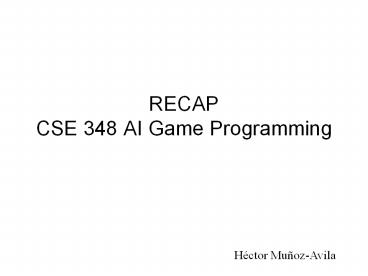RECAP CSE 348 AI Game Programming PowerPoint PPT Presentation
Title: RECAP CSE 348 AI Game Programming
1
RECAPCSE 348 AI Game Programming
Héctor Muñoz-Avila
2
Course Goal
projects
3
Controlling the AI Opponent FSMs
- FSM States, Events and Actions
- Stack Based FSMs
- Polymorphic FSM
- Multi-tier FSM
FSM
Monster In Sight
Robocode
Patrol
Fight
No Monster
A resulting plan
Monster in sight
No Monster
patrolled
Patrol
Fight
4
Controlling the AI Opponent HFSMs
Attack
Wander
E
Chase
Pick-up Powerup
E
S
S
Spawn
Start
Turn Right
D
E
Go-through Door
5
Controlling AI Opponent Scripting
- Autonomous agents calculate their action based on
(Nick Haynes)
Wargus
(Jon Martin)
Desires
Sensory Input
Proximity to items of interest
1
1
1
Space reservation quasi-coordination
1
1
6
Controlling AI Opponent Team
Unreal tournament
(Eric Lease)
- (Dayne Mickelson)
- Team sports
- Identify high-level decisions
- Multi-layered approach
- Line of sight (player, npcs)
- GOAP
- Agent can dynamically find alternate solutions to
problems
- Dead Reckoning
- Predicting future state
- For games Newton physics
- Estimate future trajectory Kinematics
7
Learning Adaptive Behavior
- Dynamic scripting Reinforcement learning
- But sometimes the problem resides in the scripts
not the ordering - Use evolutionary computation to improve scripts
(Megan Vasta)
Neural networks
- Evolve a population (each member is a candidate
solution)
8
Learning Adaptive Behavior (2)
Allegiance
(Jeff Storey)
- User model
- Flexibility beyond predefined difficulty levels
- When/what to update
Friendly
Enemy
Defense
-1.0
Weak
Strong
Medium
0.4
-0.3
0.1
- Induced from a collection of data
- Based on information gain formulas
- Assume discrete values
(Brigette Swan)
9
Learning Adaptive Behavior (3)
- Pattern recognition
- Symbols
- Optimization balancing units in an RTS game
- 2. Curse of dimensionalit
- Analysis of Machine learning Usage
- 1. Cheap to recognize what to learn from?
- 2. Cheap to store the knowledge?
- 3. Cheap to use the knowledge?
- 4. Does game benefit from learning?
(Chris Kramer)
10
Spatial Analysis
- Random map generator
- Location of players
- Map is generated step-wise by adding clumps
- Terrain analysis
- Concepts borders, corridors
- Selection of new colonies
- Spatial Analysis
Transport units in RTS games
(Russell Kuchar)
(Jay Shipper )
11
Spatial Analysis (2)
- Wall generation
- Graph representation
- (tiles, connections)
- Greedy algorithm
Hierarchy in RTS games
(Rami Khouri)
12
Path-Finding (1)
A minimize f(n) g(n) h(n)
- Grid
- Graphs
- Meshes
(Dan Bader) Rep. simplicity versus optimality
- Can be used to compute AI
(Tom Gianos) Navigation set hierarchy
String pulling
- Interface tables
- Reduction memory
- Increase performance
13
Path-Finding (2)
(Owen Cummings)
(Tom Schaible)
- Path Look-Up tables
- Several times faster than A
- But memory consumption is high
- Solution Area-based Look-up tables
- Notion of portals
- Very fast
- Throwing a grenade is not so simple!
- Add information to nodes
- Add behavior info in edges
Flying Edge
Rappelling Edge
Flying Edge
Door Edge
Vault Edge
Jump Edge
Hunting players in a convincing manner
14
Path-Finding (3)
- (Adam Balgach)
- Racing vehicle control
- Multi-layer system
- Each layer defines behavior
- Optimal racing line
- Use of Newton physics
- (Don DeLorenzo)
- Avoiding obstacles
- Should be smooth
- Crucial in dynamic worlds
a
Ra
Da
Va
Obstacle
Sidestep Repulsion
- Intelligent Steering
- Use error correction
- current error history error rate error
15
Game theory
Declarative Knowledge
Spectimax kind of search
Initial state
Goals
A
C
B
A
B
C
- HTN approach for declarer play
- Use HTN planning to generate a game tree in which
each move corresponds to a different strategy,
not a different card - Reduces average game-tree size to about 26,000
leaf nodes
- Compute expectimax and expectimin
- Evaluation functions
- Pruning search space
poker
16
Game Design
- (Peter Shankar)
- Meaningful play
- Outcome is discernable and integrated
- Elements for meaningful play
- Semiotics
- Systems
- Interactivity
- Choice
Cultural System
Experiential System
Formal System
- Sid Mier says
- personal touch is needed
17
Hall of Fame
- Winners Project 1
- Tournament Adam Balgach, Tom Gianos. Bot
Yankees - Innovation Tom Shaible, Don Delorenzo. For
"meta-level" FSM design of code. - Winners Project 2
- Tournament Adam Balgach, Tom Gianos. Team
Yankees (continuing champions!) - Innovation Swan, Brigette L, Vasta, Megan E.,
and Khouri, Rami H. For a number of interesting
ideas predicting next place for firing,
distributing battlefield, training examples. - Winners Project 3
- Project 3 was no tournament.
- Winners Project 4
- Tournament Adam Balgach, Tom Gianos. Team
Yankees (unbeatable!) - Winners Project 5
- Tournament Tom Schaible, Don Delorenzo. Team
DDTS (new champions!) - Winners Project 6
- Tournament. Owen Cummings, Dayne Mickelson Team
Tony Wonder (new champions!) - Innovation Tom Shaible, Don Delorenzo. For
decision trees and reinforcement learning
18
Acknowledgements
- Jon Martin and Eric Lease
- All of you
- Presentations were very good
- Projects were worked well (despite difficulties)
- Changes
- 4 projects robocode, UT, MadRTS, poker
- UT 2 bots only
- Poker use downloadable version
19
The End

